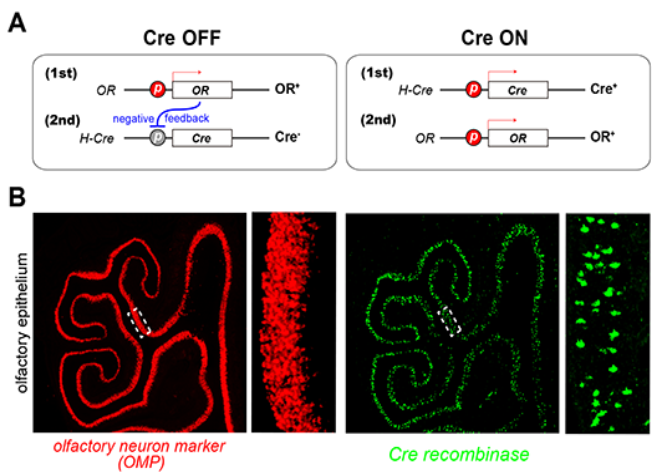|
A tool for olfactory sensory neuron-specific mosaic analysis C57BL/6-Tg(Olfr1507,ECFP)1Hsak (RBRC02930)ICR.Cg-Tg(Olfr1507-cre)1Hsak (RBRC06339)Courtesy of Hitoshi Sakano, Ph.D. (A) Schematic diagrams of the Olfr1507-Cre mosaic system. Due to negative feedback by functional OR molecules, two subsets of OSNs can be generated in the same mouse, one that is positive and the other that is negative for Cre expression. (B) In situ hybridization of sections from the olfactory epithelium in the Olfr1507-Cre mouse. Cre (green) is expressed in a subset of OSNs. Images framed by dotted lines are enlarged and shown on the right. |
| Various odorants are detected when they bind to odorant receptors (ORs) expressed by olfactory sensory neurons (OSNs). Each OSNs expresses just one allele of one functional OR, and OSNs that express the same receptor converge their axons to the same glomerulus, forming an organized glomerular map in the olfactory bulb [1]. Among ~1,000 different ORs, Olfr1507 (also known as MOR28) is one of the most frequently chosen OR genes. It is the gene that is nearest to H element, a regulatory element for OR gene cluster. In order to investigate how axons with a particular OR are converged to their destination, Sakano and colleagues generated transgenic mice for mosaic gain/loss-of-function analysis [2. 3]. Mouse H element was inserted upstream of Olfr1507 promoter in the transgene, and coding sequence of Olfr1507 was replaced with that of cre or other specific gene, and/or tagged with a fluorescent protein. Olfr1507 promoter in the transgene is highly activated prior to the other OR gene promoter due to H enhancer activity, and Cre or other protein can be co-expressed with any ORs. If one of the endogenous OR gene is expressed first, functional OR molecule negatively regulates the transgene. There will be two subsets of OSNs, one positive and the other negative for transgene expression. |
| Depositor | : | Hitoshi Sakano, Ph.D. Department of Brain Function University of Fukui |
|
| Strain name | : | C57BL/6-Tg(Olfr1507,ECFP)1Hsak | |
| RBRC No. | : | RBRC02930 | |
| Strain name | : | ICR.Cg-Tg(Olfr1507-cre)1Hsak | |
| RBRC No. | : | RBRC06339 | |
| References | : | [1] | Takeuchi H, Sakano H. Neural map formation in the mouse olfactory system. Cell Mol Life Sci.; 71(16):3049-57, 2014. |
| [2] | Serizawa S, Miyamichi K, Nakatani H, Suzuki M, Saito M, Yoshihara Y, Sakano H. Negative feedback regulation ensures the one receptor-one olfactory neuron rule in mouse. Science; 302(5653):2088-94, 2003. | ||
| [3] | Takeuchi H, Inokuchi K, Aoki M, Suto F, Tsuboi A, Matsuda I, Suzuki M, Aiba A, Serizawa S, Yoshihara Y, Fujisawa H, Sakano H. Sequential arrival and graded secretion of Sema3F by olfactory neuron axons specify map topography at the bulb. Cell; 141(6):1056-67, 2010. | ||
| October 2015 Contact: Shinya Ayabe, Ph.D. Experimental Animal Division, RIKEN BioResource Center All materials contained on this site may not be reproduced, distributed, displayed, published or broadcast without the prior permission of the owner of that content. |






